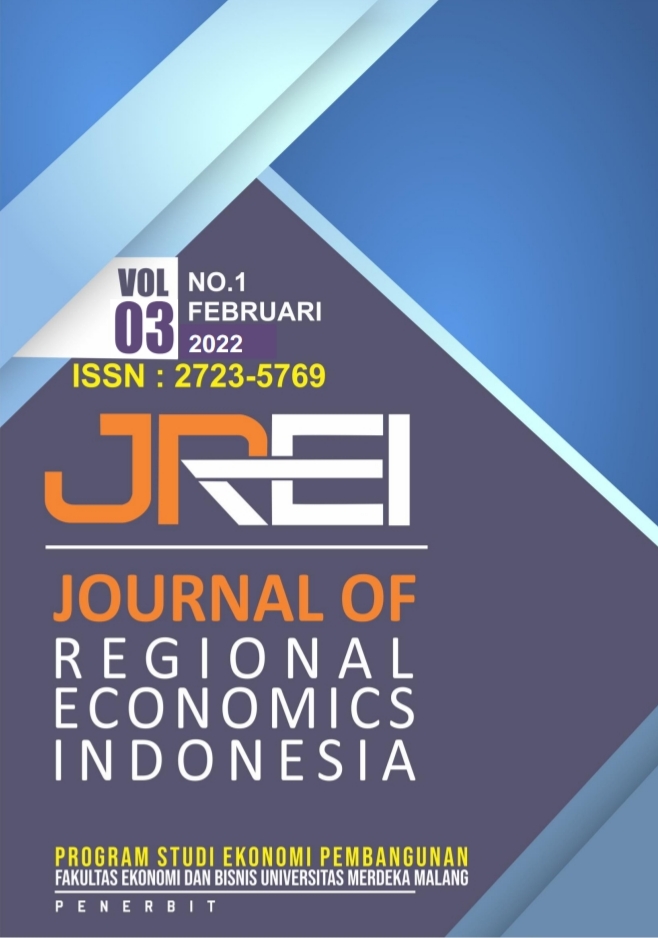Pengaruh Pertumbuhan Ekonomi, Inflasi dan BI Rate terhadap LDR (Loan to Deposit Ratio) di Indonesia
DOI:
https://doi.org/10.26905/jrei.v3i1.8007Keywords:
Economic Growth, Inflation, BI Rate, LDRAbstract
This study aims to examine the effect of economic growth, inflation and the BI Rate on the LDR (Loan to Deposit Ratio) in Indonesia. The author uses LDR as the dependent variable and includes the variables of economic growth, inflation, BI Rate, net interest income, and operating costs on operating income as independent variables. In this case, the method of writing multiple linear regression uses the OLS and ECM models for the 2016-2020 period. The results of the study show that: (i) the variable economic growth has a positive and significant effect on LDR in Indonesia; (ii) inflation variable has a negative and insignificant effect on LDR in Indonesia; (iii) the BI Rate variable has a positive and significant effect on LDR; (iv) the variable net interest income has a positive and significant effect on LDR; and (v) for the variable operating costs on operating income has a positive and significant effect on LDR in IndonesiaDownloads
References
Agustina, A. (2013). Analisis Faktor-Faktor yang Mempengaruhi Loan Deposit Ratio Bank Swasta Nasional di Bank Indonesia. Jurnal Wira Ekonomi Mikroskil: JWEM, 3(2), 101–109.
Arsyad, L. (1999). Pengantar perencanaan dan pembangunan ekonomi daerah.
Bank Indonesia. (2014). Produk Domestik Regional Bruto.
Bilian, F., & Purwanto, P. (2017). Analisis Pengaruh CAR, NIM, BOPO, dan LDR terhadap Profitabilitas Bank Persero. Jurnal Perusahaan Studi Manajemen, 2(1).
Dendawijaya, L. (2005). Manajemen Perbankan.
Hasanah, UE (2018). Pengantar Ilmu Ekonomi Makro.
Herlina, H., Nugraha, N., & Purnamasari, I. (2016). Pengaruh Risiko Kredit Terhadap Profitabilitas (Studi Kasus Pada Bank Umum Swasta Nasional Devisa Tahun 2010-2014). Jurnal Pendidikan Manajemen Bisnis (JBME), 1(1), 31–38.
Kasmir, SE (2011). MM 2010. Pengantar Manajemen Keuangan.
Mankiw, NG (2003). Teori Makro Ekonomi Terjemahan. Jakarta: PT. Gramedia Pustaka Utama.
Manurung, M., & Rahardja, P. (2004). Uang, perbankan, dan ekonomi moneter. Kajian Kontekstual Indonesia). Jakarta: Lembaga Penerbit FE-UI. Munawir.
Miskin, FS (2008). Ekonomi uang, perbankan, dan pasar keuangan. Jakarta: Salemba Empat.
Muljono, D. (1993). Analisis Hubungan Antara Likuiditas, Profitabilitas Dan Rasio Modal Pada Sektor Perbankan.
OJK Indonesia. (2016). Statistik Perbankan Indonesia.
Pohan, A. (2008). Potret Kebijakan Moneter Indonesia. Cetakan Pertama. Jakarta, PT Raja Grafindo.
Pratiwi, S., & Hindasah, L. (2014). Pengaruh Dana Pihak Ketiga, Capital Adequacy Ratio, Return Nn Asset, Net Interest Margin Dan Non Performing Loan Terhadap Penyaluran Kredit Bank Umum Di Indonesia. Jurnal Manajemen Bisnis, 5(2), 192–208.
Puspopranoto, S. (2004). Keuangan perbankan dan pasar keuangan, pustaka LP3ES Indonesia. Jakarta.
Riyadi, S. (2003). Manajemen aset dan kewajiban perbankan. Lembaga Penerbit Fakultas Ekonomi Universitas Indonesia.
Samuelson, PA (2004). Dimana Ricardo dan Mill membantah dan mengkonfirmasi argumen ekonom arus utama yang mendukung globalisasi. Jurnal Perspektif Ekonomi, 18(3), 135-146.
Saraswati, CD, & SYAICHU, M. (2014). Analisis Pengaruh Car, Npl, Nim Dan Bopo Terhadap Ldr Pada Bank Umum Yang Go Public Di Indonesia Periode 2007-2013 (Studi Pada Perusahaan Perbankan Yang Terdaftar Di Bursa Efek Indonesia). Fakultas Ekonomika dan Bisnis.
Siamat, D. (2005). Manajemen Lembaga Keuangan Edisi Kelima. Jakarta (ID): Lembaga Penerbit FE UI.
Sukirno, S. (2011). Makroekonomi: Teori Pengantar, Jakarta: PT. Raja Grafindo Persada, 333.
Downloads
Published
Issue
Section
License
License JREI: Journal of Regional Economics Indonesia, University of Merdeka Malang is licensed under Creative Commons Attribution Attribution-NonCommercial-NoDerivatives 4.0 International License.
JREI: Journal of Regional Economics Indonesia, University of Merdeka Malang is licensed under Creative Commons Attribution Attribution-NonCommercial-NoDerivatives 4.0 International License.
Copyright
Authors who publish with this journal agree to the following terms:
- Authors retain copyright and grant the journal right of first publication with the work simultaneously licensed under a Creative Commons Attribution Attribution-NonCommercial-NoDerivatives 4.0 International License that allows others to share the work with an acknowledgment of the work's authorship and initial publication in this journal.
- Authors are able to enter into separate, additional contractual arrangements for the non-exclusive distribution of the journal's published version of the work (e.g., post it to an institutional repository or publish it in a book), with an acknowledgment of its initial publication in this journal.
- Authors are permitted and encouraged to post their work online (e.g., in institutional repositories or on their website) before and during the submission process, as it can lead to productive exchanges and earlier and greater citation of published work (See The Effect of Open Access).




